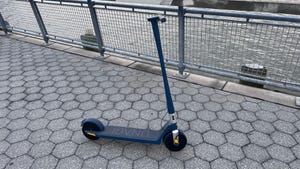
Unagi Model One Voyager Review: Gorgeous E-Scooter With More Guts - CNET
The Unagi Model One Classic was easily one of the best electric scooters available when we tested it back in 2018. With its unique looks, high-quality materials and unassuming power, the elegant, lightweight last-mile scooter remains a favorite. For 2023, Unagi has evolved the Classic into the Model One Voyager.
The Unagi Model One Voyager ($1,190 or $69 with a monthly subscription) maintains the Classic’s sleek looks while widening the rubber-covered deck, improving performance and adding new colors: matte black, cobalt blue, cool mist (green) and latte (tan). The Classic’s premium construction of carbon fiber, magnesium and aluminum, beautiful paint finishes, bright display, puncture-proof tires and single-latch folding mechanism all carry over to the Voyager.
The Voyager has almost twice the travel distance of the Classic: 12 to 25 miles on a single charge compared to the Classic’s 7 to 12-mile range. Unagi used improved battery cell technology and optimized both the motors and controllers to get the extra range, all without increasing its weight. It’s one of the lightest dual-motor scooters we’ve tested at less than 30 pounds.
The scooter can support riders up to 220 pounds. Full disclosure: I am over that recommended weight but still got some miles in along (my better — and much lighter — half was able to ride farther and faster). There are three ride modes that essentially limit speed or extend battery life, depending on how you see things. The first mode tops out at 9 mph, the second stops at 12 mph and the third gets it to 15 mph.

Cobalt Blue Unagi Model One Voyager zipping around the city.
Joseph Kaminski
The scooter can be unlocked to go 20 mph, however. To unlock the speed cap, turn the scooter on and hold both the hand brake and throttle. Continue to hold them and press the power button 10 times; you’ll hear two beeps, and it’s now unlocked. To change it back, do the same steps and listen for a single beep this time. Keep in mind that the faster the scooter goes, the quicker the battery drains, though.
The Voyager’s handlebars felt more stable than its predecessor, and I immediately noticed the improved torque (32Nm versus the Classic’s 26Nm). The ride was comfortable, especially considering the Unagi’s don’t have a suspension, and it handled well on turns. We noticed a minimal speed drop when going up inclines but nothing major.
As for charge time, that’s improved, too: The Voyager can be charged in 3 hours, which is 2 hours faster than the Model One Classic. The Voyager still sports the same electric horn found on the Classic and the regenerative and rear spoiler brake.

The folded-closed Model One Voyager in its green “cool mist” shade.
Unagi
The display on the Voyager One is the same as the Classic with only one minor difference: dual motor mode is now appropriately indicated with two-wheel icons on the screen, not just a single icon. In addition, the display shows the battery level, current speed and ride mode, and it’s also easy to read in bright sunlight.
In addition to the performance improvements, the Voyager has an iOS and Android app that extends the experience. Now riders can electronically lock and unlock the scooter from the app. This locks the wheels by creating resistance from the motors, making the scooter unrideable.

The scooter also comes in matte black.
Unagi
The app also has a useful “Distance to Empty” feature. Punch in your weight and ride mode, and the app will return a more precise travel distance for the Voyager’s remaining battery life. It really eases that “Will I make it?” anxiety. The app also allows for redundant control features on the scooter, such as turning the light on and off and changing the ride modes. You can even update the scooter’s firmware from the app.
There are two ways to get the new Unagi Voyager One. You can buy one outright from an Unagi retailer or through its subscription service. Both the scooter and Unagi storefronts are beautiful and well thought out. The scooters themselves stand out, too, partly because the scooters aren’t made with off-the-shelf parts. Unagi cares as much about the product as it does the customer experience, which may be why this company and its products have such an “Apple” look and feel to them.


